© ROOT-NATION.com - Use of content is permitted with a backlink.
With the introduction of NVIDIA DLSS 4.0 and Reflex 2, we’re witnessing another major leap forward in graphics technology.
The newly announced NVIDIA GeForce RTX 5000 series, unveiled at CES 2025, could mark a real breakthrough in gaming performance. These technologies promise to simultaneously boost frame rates, improve image quality, and reduce latency — reshaping what players can expect from high-end gaming experiences.
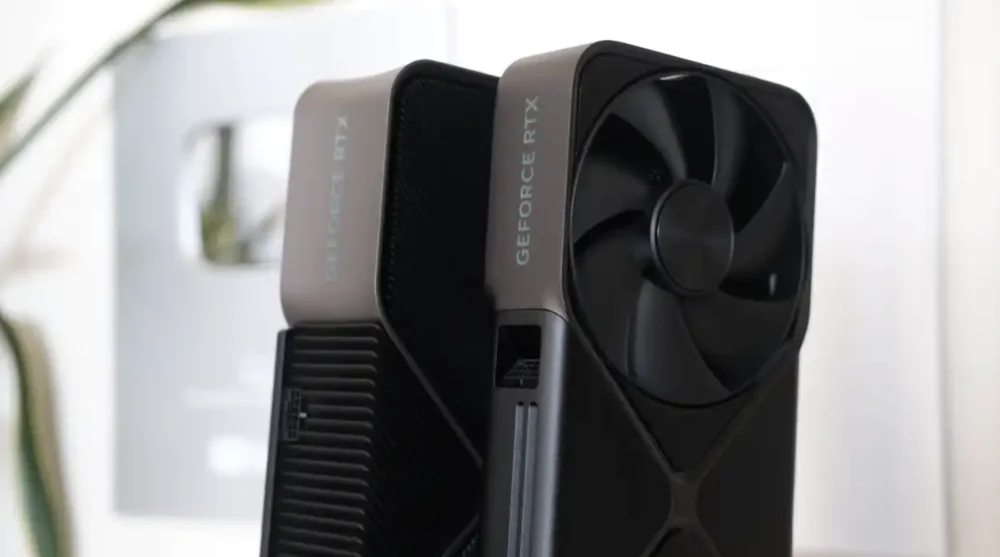
In this article, I’ll break down how DLSS 4.0 differs from its earlier versions, including DLSS 3.5, and take a closer look at its new AI architecture based on transformer models. I’ll also cover what Reflex 2 brings to the table and what all of this means in real-world use. Naturally, we’ll be looking at everything from the most important perspective — that of the player.
Read also: AI Hallucinations: What They Are and Why They Matter
NVIDIA DLSS 4.0 is a revolution, not an evolution
DLSS, short for Deep Learning Super Sampling, is NVIDIA’s suite of neural rendering technologies that use artificial intelligence to make game rendering more efficient. In earlier versions (DLSS 2.x and 3.x), this meant rendering frames at a lower resolution and using AI to upscale them, boosting frame rates while improving image quality.
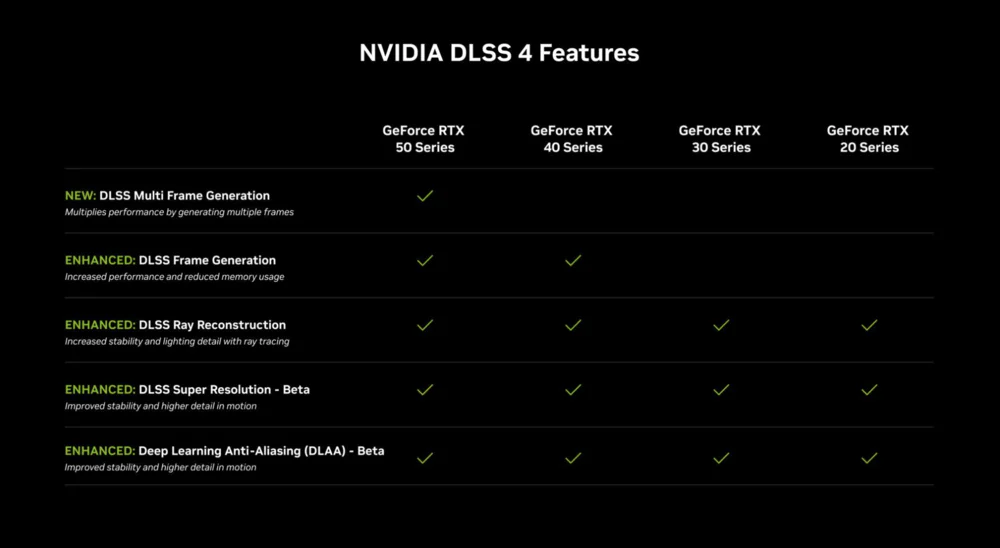
However, DLSS 3.5, released in late 2023, introduced the first major addition in the form of Ray Reconstruction — an AI-driven technique for denoising ray-traced effects. Still, DLSS 4.0 is arguably the most significant update since DLSS 2.0 launched in 2020. Why? Because it brings together several major advancements, including:
- Multi-Frame Generation (MFG). DLSS 4.0 is capable of generating up to three additional frames for every one actually rendered, while DLSS 3 could only add one AI-generated frame. In practice, this could boost frame rates by up to eight times compared to traditional rendering. Theoretically, this opens the door to playing games in 4K at 240 FPS with full ray tracing enabled on top-tier GPUs — a major leap forward in frame rate performance.
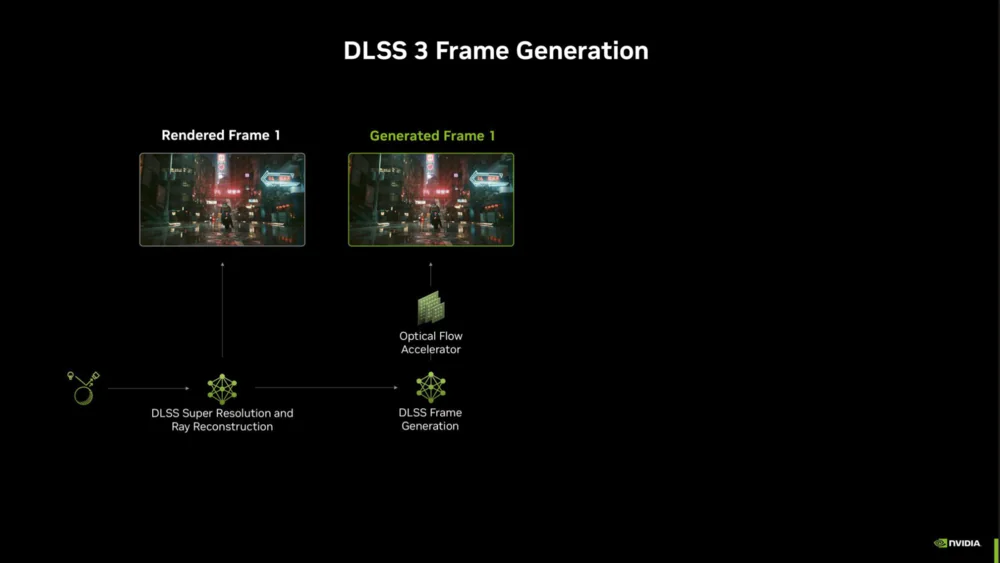
- Transformer-based AI models. NVIDIA has updated DLSS algorithms with a new transformer-based architecture, marking the first use of transformers in real-time gaming graphics. Compared to the convolutional neural networks used previously, the DLSS 4 transformer model has twice as many parameters and a deeper understanding of each scene, leading to noticeably improved image quality.
- Improved image quality. Thanks to more advanced processing, DLSS 4.0 delivers more stable frame rates, significantly reduces image doubling, and offers higher detail during motion compared to DLSS 3.5. Fine textures and edges are expected to appear sharper, while fast-moving objects should retain more detail without the smearing or flickering often seen in earlier versions.
- Enhanced frame generation pipeline. NVIDIA didn’t just add more frames — they also improved the entire frame generation process. The new DLSS 4 frame generator is expected to be around 40% faster and use about 30% less video memory compared to DLSS 3. In practice, this means that with a single generator call for each real frame, multiple intermediate frames can be produced, reducing the overall load on the system.
- Broader support and backward compatibility. Another positive aspect is that DLSS 4.0 isn’t limited to new GPUs. While the key Multi Frame Generation feature requires the latest GeForce RTX 5000 series, older RTX cards still benefit. GPUs from the RTX 20, 30, and 40 series can take advantage of the new super resolution, ray reconstruction, and transformer-based DLAA improvements.
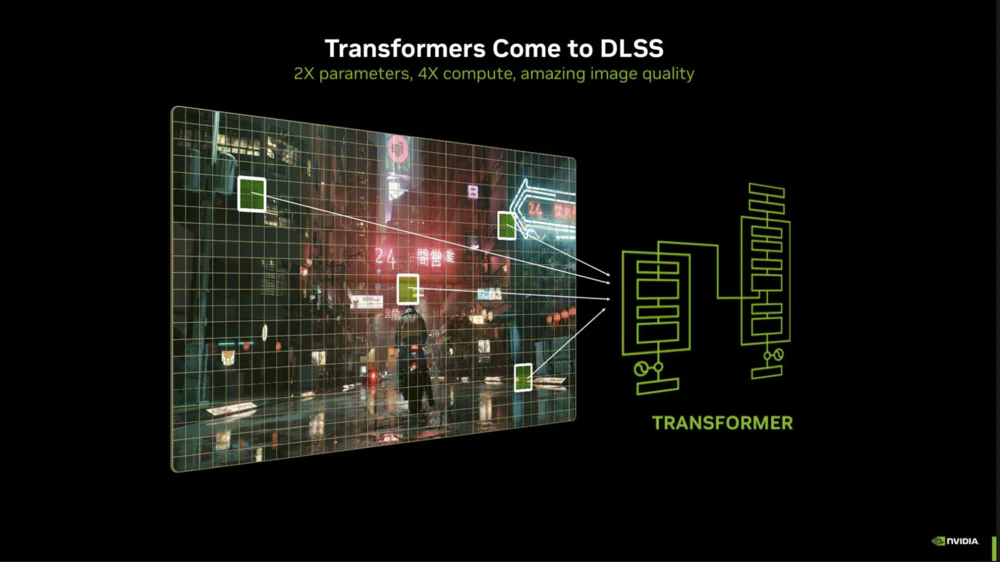
Read also: Techno-feudalism – A New Form of World Order
DLSS 4.0 transformer architecture for intelligent motion scaling and reconstruction
NVIDIA DLSS 4 will be the first scaling technology to use a new real-time transformer model. The Super Resolution and Ray Reconstruction solutions, which are based on the new transformers, will now use twice as many parameters and four times more computational power, resulting in greater image stability during movement, minimizing halos on moving objects, higher image detail, and improved edge smoothing. All DLSS 4 enhancements, except for the frame generator (scaling, ray reconstruction, DLAA), will be available on all GeForce RTX GPUs. NVIDIA DLSS 4 is expected to not only deliver much better visual scaling but also up to 8 times higher performance compared to traditional native resolution rendering, largely thanks to the Multi Frame Generation feature.
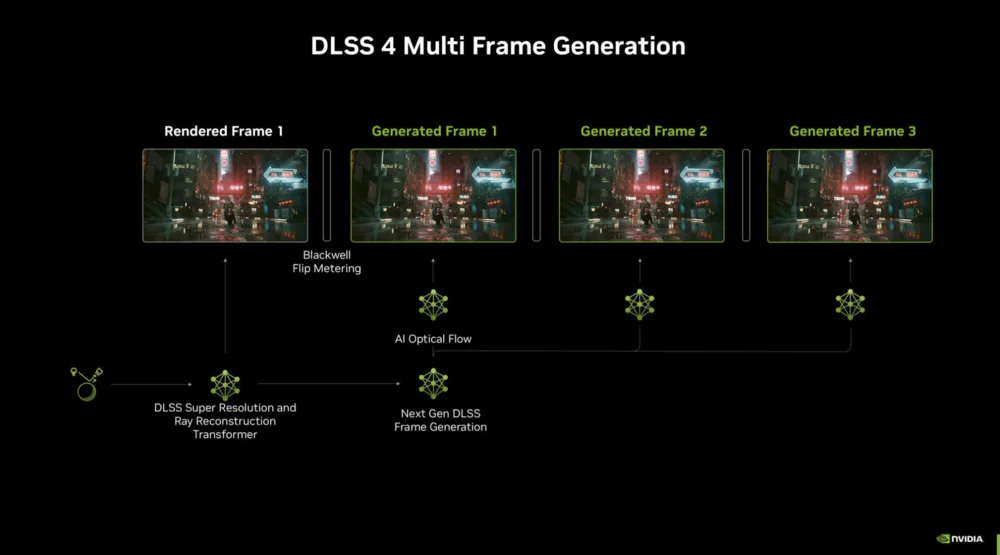
One of the main distinguishing features of DLSS 4.0 is the new transformer-based AI model — DLSS Transformers. These are the same class of AI models that power natural language processing (such as ChatGPT), but NVIDIA has adapted them for real-time image processing. This is not just a change, but a significant improvement, as transformers excel at understanding context and relationships in data, in this case, pixels in a given frame and the subsequent frames.

The effect? The new model uses the Vision Transformer architecture, which applies attention to the entire frame (and even across consecutive frames). In practice, it doesn’t just analyze a small block of pixels separately, but rather looks at the whole image and previous frames to best reproduce all the details. This global approach allows the AI to recognize, for example, that the edge of an object in one frame should align with its movement in the next, or that a texture pattern (like a fence mesh) should remain consistent rather than flickering.
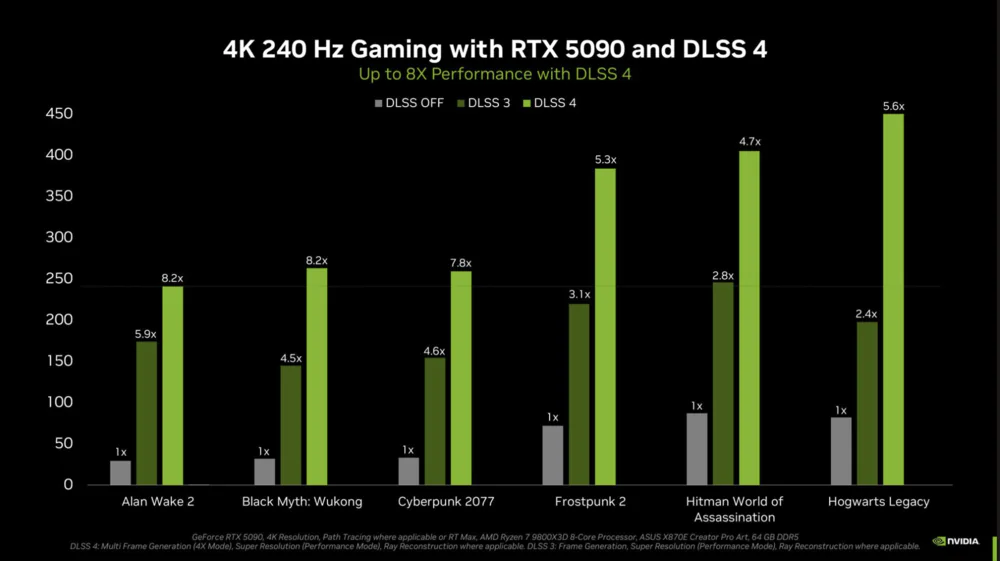
In practice, this results in a much sharper and more stable image. Early examples, like Alan Wake 2, have already demonstrated the benefits of this approach. Small details, such as a mesh fence, remain smooth and stable instead of flickering, moving fan blades leave no ghosting, and thin objects, like power lines, don’t blink under changing light conditions. In other words, the transformer eliminates many motion artifacts and overlay issues that previous versions of DLSS or other upscalers couldn’t handle.

Read also: Panama Canal: History of Its Construction and Basis of U.S. Claims
Multi Frame Generation, or you’ll finally stop complaining about smoothness in games
Another significant advancement in DLSS 4.0 is Multi-Frame Generation (MFG), which builds upon the frame generation feature introduced with DLSS 3. Multi-Frame Generation extends the frame generator that first appeared with the Ada Lovelace architecture. Using AI algorithms, it can now generate up to three additional frames for each image frame rendered in the traditional way. Thanks to the much more advanced 5th-generation Tensor cores, this feature is currently limited to NVIDIA GeForce RTX 5000 series GPUs and their laptop counterparts. The new Tensor cores provide 2.5 times the AI processing performance compared to the 4th-gen Ada Lovelace cores. Once the new frames are generated, they are evenly distributed to ensure smooth performance.
Instead of adding a single artificial frame for every real frame, DLSS 4.0 goes a step further by inserting three additional frames into the entire rendering pipeline. In practice, the GPU renders one “real” frame, while the DLSS system generates three additional inter-frame images. This means that for every rendered frame of the game, four are displayed. The question then arises—how is this even possible without increasing latency?

To understand this approach, NVIDIA had to redesign the entire frame creation pipeline. Previously, generating each artificial frame required separate optical flow calculations and neural network processing, which was too costly when generating a large number of frames.

In DLSS 4.0, this issue has been addressed, making the AI much more efficient for each frame. The updated frame generator model (still based on a neural network, though not necessarily a transformer) runs once and generates multiple intermediate frames. It’s 40% faster and uses 30% less memory than before. As a result, the technology demands less from the components while still delivering the DLSS magic. In practice, this multi-frame generation ensures a significant performance boost, particularly on high-performance graphics cards.

It’s worth noting that NVIDIA strictly manages input latency with the frame generation feature. Traditionally, adding artificial frames can increase input delay, as these frames don’t reflect the player’s new movements, leading to reduced responsiveness in games. This is why NVIDIA Reflex has always been paired with DLSS 3 to synchronize game simulations. Now, with DLSS 4, despite generating even more frames, NVIDIA claims that latency has been reduced by as much as half. How? Primarily due to improvements in Reflex technology (which we’ll discuss later), as well as partially due to better DLSS performance. With the GPU not being overloaded, it can process new input data more quickly.
Read also: 10 Mistakes That Simplify the Work of Hackers
Reflex 2: NVIDIA reduces input latency like never before
A high frame rate is good on its own, but for the best gaming experience, it needs to go hand-in-hand with low input latency, especially for players engaging in fast-paced games. Without this, the game can feel like moving through thick mud. This is where NVIDIA Reflex 2 comes in, the successor to the Reflex technology introduced in 2020. This solution reduces system latency by optimizing the connection between the CPU and GPU.

It works by synchronizing the GPU with the CPU and eliminating bottlenecks in the rendering queue. This means that mouse clicks reach the screen faster. Of course, many games already support Reflex 1.0, often reducing latency by 30-50%, but Reflex 2 goes much further by introducing a new technique called Frame Warp.
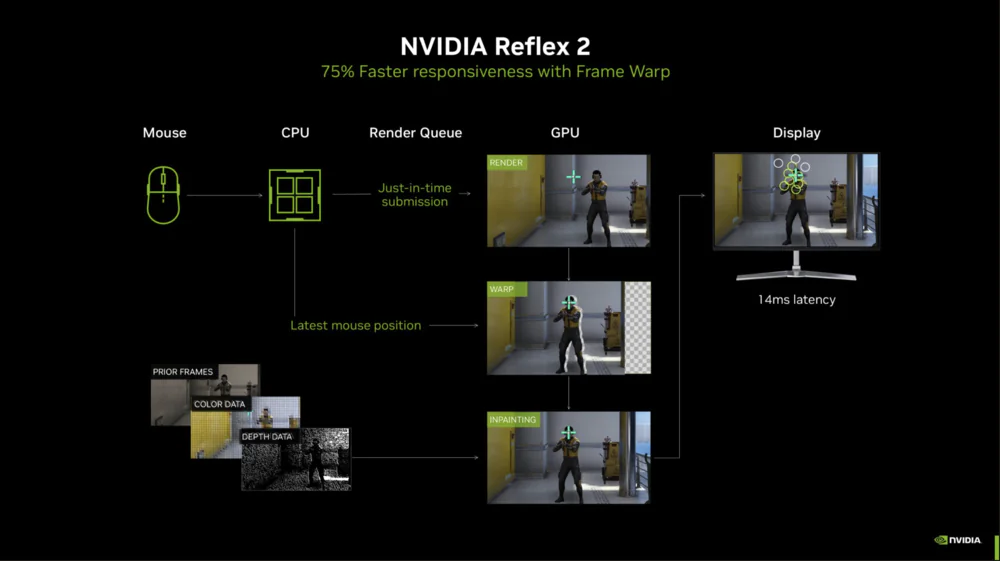
At CES 2025, NVIDIA announced that Reflex 2 can reduce PC latency by up to 75%. How is this possible? With Frame Warp, the system not only renders frames faster but also reworks them in the last millisecond, taking into account the most recent input data.
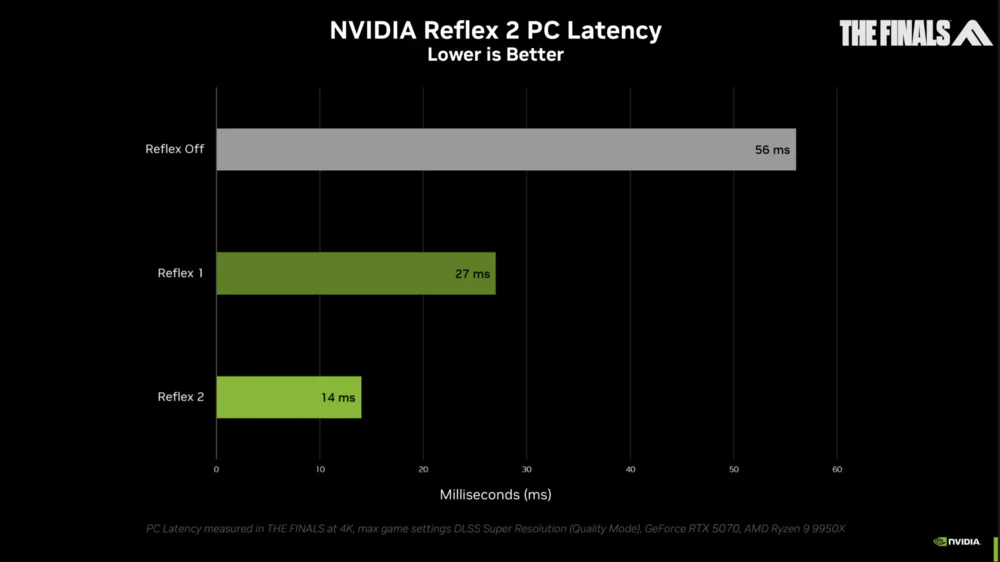
In other words, even after the GPU renders a frame, Reflex 2 can still adjust the camera or crosshair position just before the frame is displayed to account for the player’s latest movements. The way it works is that, while the GPU renders frame X, the CPU simultaneously predicts where the player’s camera or crosshair will be in frame X+1 based on the most recent mouse or controller movement. Once the GPU finishes rendering frame X (based on slightly older data), the system warps the frame to match the new camera position for frame X+1. This modified frame is then sent to the screen.

Interestingly, this approach is similar to methods used in virtual reality, such as asynchronous reprojection. The principle behind it is that if the last frame in a VR headset is slightly outdated, the system modifies it to reduce the perceived latency for the player. Here, this concept has been adapted for mice and computer games. The result? A significant reduction in latency—from several dozen milliseconds down to a handful… or even lower for less demanding games. Unfortunately, Reflex 2 is currently available only in a few games, such as Valorant or The Finals, and requires an NVIDIA GeForce RTX 5000 series graphics card to function.
Read also: How Taiwan, China and the US are fighting for technological dominance: the great chip war
Game support and developer adoption of DLSS 4.0
Even the best technology is useless if it’s not utilized. Fortunately, NVIDIA made sure that DLSS 4.0 would have broad support from the start. When the GeForce RTX 5000 series GPUs launched, the company announced that 75 games and applications would support Multi Frame Generation (MFG) on day one. This number continues to grow every month. Today, we can already experience DLSS 4.0 in Cyberpunk 2077, Alan Wake II, Diablo IV, God of War Ragnarok, and Star Wars Outlaws.
It’s also important to note that not only new games can benefit from DLSS 4. Thanks to NVIDIA’s focus on backward compatibility, game developers who have already implemented DLSS 2 or 3 can easily update their titles to support DLSS 4.

Often, simply updating the DLSS plugin is enough to activate the new transformer model and Multi Frame Generation. Even less responsive studios and developers are not a barrier, as NVIDIA offers an alternative through the override feature in the DLSS SDK. With this, users can manually force DLSS settings on supported games, even without an official update to the game itself.
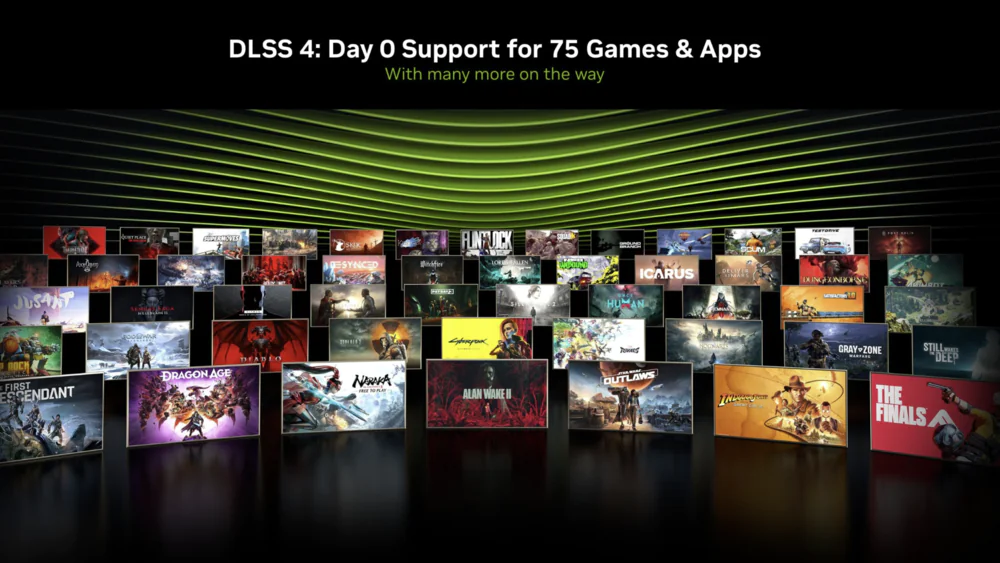
Today, it’s clear that AI-driven rendering has become one of the pillars of modern game development. This technology is rapidly advancing, but NVIDIA ensures that future versions are not only at least partially compatible with older ones but also easy to implement. This is crucial, as for the technology to be more beneficial, we would need a cutting-edge hypernova solution, even if its support were minimal. However, only time will tell if DLSS 4.0 and, more so, Reflex 2 will receive broad support in games, and whether competitors like Intel and AMD will offer something similarly advanced and efficient.
Read also: Are Noise-Canceling Headphones Harmful? Insights from Audiologists
Why DLSS 4.0 and Reflex 2 are so important
These technologies are highly significant for modern games and real-time performance, particularly for gamers and content creators. First and foremost, DLSS 4.0 is important because it enables higher performance without compromising image quality. This means more frames per second, even in demanding scenes. Additionally, DLSS 4.0 predicts details more accurately, works more efficiently with motion, dynamics, and scene depth. All of this is thanks to the new AI architecture based on transformers. The combination of ray tracing and DLSS allows for realistic graphics without critical FPS drops. Moreover, DLSS 4.0 effectively scales up to ultra-high resolutions without losing sharpness.

Reflex 2 is equally important for gameplay, as it reduces input lag, which is crucial for esports and FPS games. Reflex 2 synchronizes the GPU and CPU more precisely, minimizing delays. In games like CS2, Valorant, and Apex Legends, even a few milliseconds can determine the outcome of a battle. Actions become noticeably sharper and instantaneous. This is not just about comfort — it’s a competitive edge. The Reflex Latency Analyzer tool allows for precise measurement of system latency.
That’s why all gamers are eagerly awaiting the new GeForce RTX 5000 graphics cards, which will leverage the latest NVIDIA DLSS 4.0 and NVIDIA Reflex 2 technologies. How these will perform in practice remains to be seen, but we will keep you updated on everything.
Read also:
- Use It or Lose It: How AI is Changing Human Thinking
- All About Microsoft’s Majorana 1 Quantum Processor: Breakthrough or Evolution?

